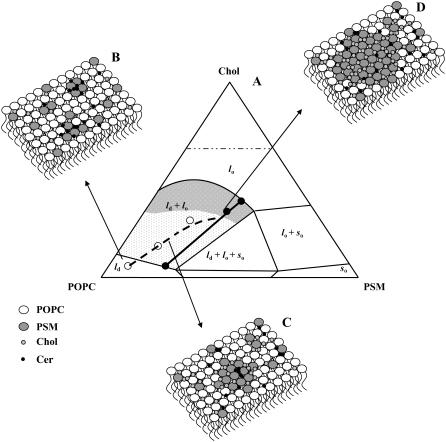FIGURE 7.
Schematic representation of the effect of PCer in lipid rafts biophysical properties and organization. (A) By recruiting PSM, PCer changes the composition of the mixtures and consequently the position of the tie line of the remaining fluid phase. The dashed black line and the white dots correspond to the estimated composition of the fluid phase that remains after the sequestering of PSM for gel-domain formation (see text for details). When increasing Chol content, the effect of PCer is opposed and less PSM is recruited for domain formation until 25%–33% Chol is reached and gel-domain formation completely abolished. Thus, the line that defines fluid phase composition should connect with the tie line in this region. According to this model, Xlo should decrease from 26% and 58% to 21% and 54%, respectively, when 4% PCer is present. (B) For the 100% ld phase one PCer molecule recruits up to three PSM molecules and forms highly ordered PCer/PSM-gel domains. The amount of gel formed is considerable, XG ∼ 15%, but the size of the domains is small, ∼4 nm (see Discussion). Panels B, C, and D are a pictorial top view of the bilayer because ∼250 molecules should be involved in the formation of a nanodomain of this dimension. (C) In the low-to-intermediate XChol, i.e., in the range of small sized rafts, PCer/PSM-gel domains are still present and are surrounded by lipid rafts (lo phase). FRET experiments show that PCer is not forming platforms or promoting the coalescence of the small rafts into large ones. (D) In the high Chol, large sized rafts range, PCer ability to form gel domains with PSM is abolished by the presence of Chol that competes for the association with PSM. In this situation, lipid rafts are governing membrane properties.

